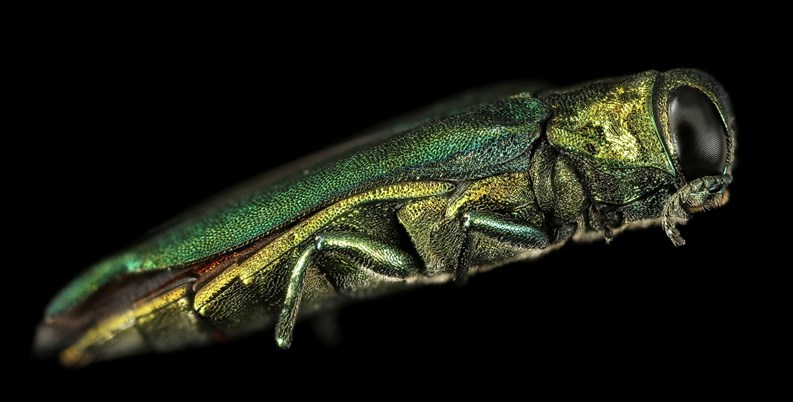First of a two-part article.
Who knew that such a tiny insect could wreak so much havoc throughout the country?
That dubious distinction belongs to the emerald ash borer (EAB), which is native to Asia and bad news here in the U.S., where the insect is present in 27 states, including New York and New Jersey, according to the New Jersey Department of Agriculture. Metallic-green in color and measuring just a half-inch long and one-eighth wide, the emerald ash borer is responsible for the death of tens of millions of ash trees in Michigan, where it was first discovered in 2002, and hundreds of millions of trees in the affected parts of the U.S and Canada. The U.S. Forest Service says that the cost for treating, removing and replacing infected ash trees is estimated to be $10.7 billion. Some condo associations in parts of the country with ash trees have addressed the emerald ash borer problem in online announcements.
The emerald ash borer was first confirmed in New York State in 2009 by the Department of Environmental Conservation (DEC), and has been known to known to exist in at least 12 counties, including Albany, Ulster, Erie and Dutchess. The New Jersey Department of Agriculture said that infestations of the emerald ash borer, which was first detected in the Garden State two years ago, have been found in six counties—Bergen, Burlington, Mercer, Middlesex, Monmouth and Somerset—as of June 2016.
Origins and Introduction
Patrick Parker, plant health care director of SavATree, a tree and shrub care company with offices in 10 states and the District of Columbia, says the arrival of the emerald ash borer into the U.S. could be attributed to global commerce. “A lot of the most destructive insects we've had actually come in on wood crate packing materials where the insects themselves are already inside the wood when the packing material came into the country,” he says, “We see a lot of infestations start that way. Some of the larger port cities are where you'll see these infestations start, where those products come in. Other times they could be brought in with plant material that's imported from other areas.”
He also adds that emerald ash borer doesn’t have any natural enemies here in the U.S. compared to their country of origin. “Often they have similar trees back where they are from, so they are able to attack similar related trees here without natural predators and defenses,” Parker explains. “They can usually overwhelm our native trees. Whereas in their own countries, there are predators—there's trees that have developed defenses over the years, so they are able to fight them off there.”
Emerald ash borers were discovered in the Great Lakes area in Detroit 14 years ago but might have been around as early as 1994, according to Paul Kurtz, an entomologist with the New Jersey Department of Agriculture. “Since then the insect has spread to now 27 of the 48 continental United States, and killed over 350 million ash trees, and that’s a conservative estimate,” he says. “They're a small beetle, with a metallic bright green shell or elytra with a distinctive copper red abdomen.”
Effects on Ash Trees
The emerald ash borer's damage on ash trees affects the tree's ability to carry water, says Gerard Marzocca, operations manager at Integrated Plant Health Care Systems in Branchburg, New Jersey. “The insect is feeding on the interior layers of the tree that can move water from the soil up to the leaf,” he says. “As the tree becomes damaged by the larvae, it cannot not move water so well up the tree. Then the tops of the tree begin to lose leaves and look thin and bare. The interior layer of the tree is how the tree moves the water up.”
Kurtz says that the emerald ash borers may appear innocuous because of its size. But they reproduce exponentially, targeting stressed trees before moving on to healthier trees, and in turn impacting the environment. “Because trees don't move,” he says, “it is easier for insects to become established in an area. As the trees die it has broad negative impacts on the ecosystem and food chains. The trees are a habitat and food source for all the other creatures of the forest. When you look at all the native insects that feed on the trees that then are food for other animals and work up the food chain, many animals rely on the trees for food and habitat. Once you lose that forest, you have the full displacement of large mammals—bears, wolverines—in some areas to birds and other smaller mammals. So effectively you're breaking the entire food web with a very small invasive beetle. It’s that butterfly or ripple effect that will impact all the species that live in the forest.”
There are treatments that can be made on a preventative basis for emerald ash trees, says Parker. “We can treat infested trees, but we have to catch them early before they're showing very much signs of dieback [a condition when the tree begins to die, starting with the tips]. So if we could get to them before they, say lost 20 percent, of their canopy top layer, then we could usually turn them around.”
David Chiu is associate editor of The Cooperator and other publications.







Leave a Comment